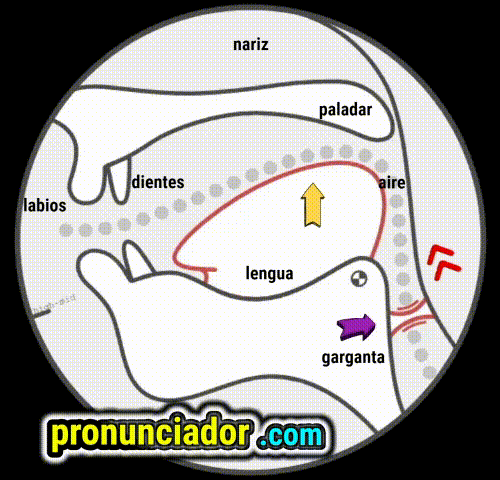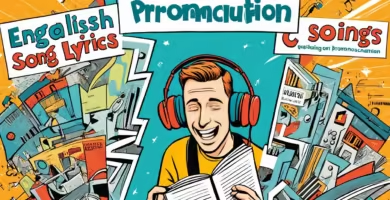
Struggle with the English /f/ sound? Learn the simple lip-to-teeth action to fix common F vs. V and F vs. P errors. Master all spellings like PH and GH!
Hey, future American English sound masters! Get ready to fine-tune a consonant that seems simple, but has a few sneaky tricks up its sleeve, especially with spelling: the /f/ sound, as in “fun,” “fish,” “phone,” or even “laugh“! Its secret phonetic symbol is just /f/ – nice and easy!
Now, you might think, “The ‘F’ sound? I use it all the time in my language!” And many of you do! The basic idea of air passing through a small opening is common. But the American English /f/ requires a specific lip-to-tooth contact and a good, continuous stream of airy friction to sound truly clear and native.
What kind of “F”umbles do learners often make?
- The “P” Problem: Do you accidentally block the air completely with both lips, making “fun” sound like “pun”? This turns our airy /f/ into a lip-popping /p/!
- The “V” Mix-Up: Or maybe you add a “throat buzz” (voice) to your /f/, making “fine” sound like “vine”? Remember, /f/ is a quiet, airy sound!
- The “Weak Whiff”: Does your /f/ sound too soft or barely there? You might not be getting enough friction (that hissy air sound).
- The “Lips-Only” F (Bilabial Fricative [ɸ]): Some learners use only their lips to make a similar airy sound, without the crucial top-teeth-on-bottom-lip action. This isn’t the American /f/!
- Spelling Nightmares! This is a BIG one! ‘F’ is easy. ‘FF’ is easy. But PH sounding like /f/ (“phone”)? And worse, GH sometimes sounding like /f/ (“laugh,” “enough,” “cough“)?! It feels like a spelling prank!
All this can make your English sound a bit off, and it’s totally understandable to feel frustrated! You just want your words to sound clear and confident!
But fear not, “F”-tastic friends! Today, we’re turning you into an American /f/ sound FORCE! This ultimate, super-EASY guide (explained so simply even your 8-year-old self would get it instantly!) will unlock ALL the secrets:
- Meet the Airy /f/: What is this “bottom-lip-to-top-teeth-NO-voice-WHOOSH!” sound?
- The “Lip-Teeth Lock” (Kid-Style!): Ultra-simple, step-by-step mouth moves for the perfect /f/ – it’s easier than you think!
- F vs. V vs. P Power-Up! Crystal clear differences so you NEVER mix them up again! (It’s all about VOICE and AIRFLOW!).
- FRICTION is Your Friend! How to get that strong, continuous “ffffff” sound.
- Spelling SECRETS Revealed! F, FF, PH (easy!), and the TRICKY GH (/f/ words like “laugh,” “cough,” “enough,” “tough,” “rough”!). We’ve got the lists!
- Zap Common “F”-ailures! No more “pish” for “fish”!
- “Feel the Flow!” /f/ Practice Fun! Awesome drills with super common words (‘for’, ‘if’, ‘life’, ‘phone’, ‘coffee’, ‘laugh’) to make your American /f/ fabulous!
Get ready for your “five,” “family,” “photo,” and even “enough” to sound fantastic and friction-filled! Let’s have some fun /fʌn/! 😉
What is This “Lip-to-Teeth Air” /f/ Sound, Anyway?
First, let’s formally introduce our consonant of the day: the /f/ sound. It’s a very common sound in American English, appearing in about one-tenth of all English words! You know it from words like:
- fun /fʌn/
- fish /fɪʃ/
- off /ɔf/ or /ɑf/
- life /laɪf/
- photo /ˈfoʊtoʊ/
- laugh /læf/
The /f/ is one of the nine Fricative Consonants in American English. . “Fricative” sounds fancy, but it just means it’s a sound made by squeezing air through a very narrow passage in your mouth, creating friction – that hissy or breathy sound!
Its Secret “F”-eatures (Made Kid-Easy!)
The sound experts (geeks!) describe /f/ as a “labiodental, voiceless, fricative consonant.” Let’s make that super clear:
- Labiodental (LIP + TEETH!): This tells us where the magic happens!
- “Labio-” means LIP (specifically, your bottom lip).
- “-dental” means TEETH (specifically, your upper front teeth).
- So, for /f/, your BOTTOM LIP gently touches or presses against your UPPER FRONT TEETH. This creates that narrow gap for the air to squeeze through!
- Voiceless (NO THROAT BUZZ! Shhh!): This is super important! Your vocal cords (your voice box) are turned OFF. They DON’T vibrate. The /f/ sound is made only with air rushing out. If you touch your throat while saying “fffff,” you should feel NO buzzing. It’s a quiet, airy consonant.
- Fricative (Continuous AIR WHOOSH!): This means the air flows CONTINUOUSLY through that lip-to-teeth gap. It’s not a quick pop or explosion of air (like /p/ or /b/). It’s a steady stream of air that makes a hissy “fffffff” sound. You should be able to hold it: ffffffffffff!
Super-Simple “Windy Day” Summary for /f/:
- Open your mouth just a little.
- Gently bring your BOTTOM LIP up to touch the bottom edge of your UPPER FRONT TEETH. (Don’t bite hard!)
- Keep your voice box QUIET (no humming!).
- Now, BLOW AIR continuously so it “whooshes” out between your lip and teeth! “Ffffffff!”
It should sound like a soft, windy hiss!
The ULTIMATE F vs. V Showdown: AIR vs. BUZZ! (Lips & Teeth Stay PUT!)
This is THE most critical distinction for /f/! The /f/ sound (“fan”) and the /v/ sound (“van”) are like identical twins made in the EXACT SAME MOUTH POSITION (bottom lip to upper teeth)!
The ONLY, ONLY, ONLY Difference = VOICING (Throat Buzz):
| Feature | /f/ (Fan, Life, Safe) | /v/ (Van, Live (verb), Save) |
| Lip-to-Teeth Contact? | YES! (Bottom lip, Top teeth) | YES! (Bottom lip, Top teeth) |
| Continuous Airflow? | YES! (“ffffff”) | YES! (“vvvvvv”) |
| THROAT BUZZING? | OFF! (VOICELESS – Just Air!) | ON! (VOICED – Buzzing!) |
#1 Learner Mistake: Using voice for /f/ (making it /v/), or no voice for /v/ (making it /f/).
- “Fine” /faɪn/ might accidentally become “Vine” /vaɪn/.
- “Save” /seɪv/ might accidentally become “Safe” /seɪf/.
The Magic Fix: The THROAT BUZZ CHECK! Fingers on your throat! - Say “fan” /fæn/. Feel that continuous airy “fffff.” NO BUZZ! That’s /f/!
- Now say “van” /væn/. Feel that continuous buzzy “vvvvv.” YES! A definite BUZZ! That’s /v/!
Practice switching that “voice motor” ON and OFF while keeping your lip-to-teeth position exactly the same! This is pronunciation gold!
The F vs. P Battle: AIR WHOOSH vs. LIP POP!
Another common mix-up is /f/ (airy) vs. /p/ (poppy)!
- /f/ (Fish): LabioDENTAL Fricative. Bottom LIP + Top TEETH. Air flows CONTINUOUSLY with friction (“ffffff”). Voiceless.
- /p/ (Pish – not a word!): BiLABIAL Stop. BOTH LIPS together. Air STOPS completely, then POPS out. Voiceless.
Learner Trap: Pressing both lips together for /f/ and stopping the air, then popping it (making a /p/). Or, using only lips (no teeth) and still stopping air.
The Fix: For /f/, it’s BOTTOM LIP lightly touching TOP TEETH. Air MUST keep FLOWING like a gentle wind. For /p/, it’s BOTH LIPS pressed together, air STOPS, then “Pop!” No teeth involved directly.
- Feel it: Fun (air whooshes) vs. Pun (air pops).
What About That [ɸ] Sound? (The “Lips-Only F”)
Some languages have a sound called a voiceless bilabial fricative, symbol [ɸ]. It’s like an /f/ sound made only by bringing the lips close together and blowing air through them, with NO teeth involved.
American /f/ is NOT [ɸ]! For the true American /f/, that bottom lip MUST make contact with the upper teeth to create the correct friction and sound. Using only lips will sound weak or slightly different.
Your Mouth’s “Feathery Friction” Action: Making /f/ Step-by-Step!
Let’s get that perfect, airy American /f/ sound!
Step 1: Mouth Slightly Open, Lips Relaxed (to start).
Keep your mouth just slightly open and your lips initially relaxed. You don’t need a wide grin or a tight pucker to begin.
Step 2: Gentle Lip-to-Teeth Lock-In!
This is where the /f/ is made!
- Lightly bring your BOTTOM LIP up.
- Gently PRESS the inside/backside of your bottom lip against the very bottom edge of your UPPER FRONT TEETH.
- It should be a soft, light touch, just enough to create a very narrow opening. Don’t bite hard!
Step 3: Airstream – The Continuous “Whoosh”!
- Now, with your lip and teeth gently touching, BLOW a steady stream of air OUT of your mouth.
- The air should flow continuously OVER your lower lip and through that tiny gap between your lip and teeth.
- You should hear (and feel on your hand if it’s close) a clear, consistent FRICTION sound – like a soft “fffffffff”. This friction is key!
Step 4: Voice Box – Total Silence! (Voiceless)
- Remember, for /f/, your vocal cords (throat) are OFF. No buzzing, no humming.
- It’s purely an air sound. If you feel a buzz, you’re making a /v/!
Putting It All Together: Kid-Friendly “Feather Blow”!
“Imagine you have a tiny, light feather sitting on your bottom lip. Now, gently bring your top teeth down to just barely touch that feather (and your lip!). Keep your voice quiet (shhh!). Now, blow softly and steadily to make the feather float away! Ffffffffff! That airy whoosh is your /f/ sound!”
Critical Feeling: Light contact of inner bottom lip to upper teeth edge. Continuous, hissy airflow. NO throat vibration. It should feel easy and airy!ur speech.
“F” Spells…? The /f/ Sound’s Surprising Disguises! (F, FF, PH, GH)
Good news and tricky news! The /f/ sound is MOSTLY spelled with ‘F’ or ‘FF’. But then come PH and the wild GH!
The Reliable Duo: ‘F’ and ‘FF’! (~83-84% + ~7-8% = ~91%!)
- Letter ‘F’: The MAIN WAY!
- Most words with the /f/ sound use a single ‘F’.
- fun, fish, for, from, life, if, myself, self, leaf, half, wife.
- Double ‘FF’: Still just ONE /f/ Sound!
- When you see ‘FF’, it makes one single, normal /f/ sound. Not longer, not stronger.
- coffee, off, effect, stuff, different, offer, office, cliff, puff.
The Greek Imposter: ‘PH’ = Always /f/! (~8%)
This is a very reliable rule! Whenever you see ‘PH’ together, it almost always represents the /f/ sound. These words usually have Greek origins.
- phone, photo, phrase, graph, dolphin, elephant, alphabet, Joseph, Stephen, triumph, paragraph, philosophy, geography.
- (Rare exception: ‘shepherd’ where ‘ph’ can be /p/ by some, but this is highly unusual and not a general rule for PH).
The Wild Card: ‘GH’ = Sometimes /f/! (Very Few Words, but Common Ones!)
This is the trickiest one! ‘GH’ can be silent (though, night), /ɡ/ (ghost), OR, in a small but important group of words (usually at the END), it sounds like /f/! You mostly have to MEMORIZE these!
- Laugh /læf/
- Cough /kɔf/ (or /kɑf/)
- Enough /ɪˈnʌf/
- Tough /tʌf/
- Rough /rʌf/
- (Maybe: draught /dræft/ (AmE usually, UK /drɑːft/ with different vowel too). Not as common).
Super /f/ Spelling Summary:
| Spelling(s) | Frequency (Web Chart) | Reliability for /f/ | Key Examples | Notes |
| F | ~84% (KING!) | VERY HIGH | fun, life, if, of* | *’Of’ /əv/ is an exception! |
| FF | ~7% | VERY HIGH (Single /f/) | coffee, off, stuff | |
| PH | ~8% | ALMOST ALWAYS /f/! | phone, graph, dolphin | Greek origin words. |
| GH | ~1% (very small) | RARE & IRREGULAR! MEMORIZE! | laugh, cough, enough, tough | Usually END of word, small specific list. |
Main Idea: ‘F’ and ‘FF’ are your go-to. ‘PH’ is your reliable friend for /f/. ‘GH’=/f/ words are special VIPs you need to learn by heart!
Oops! Common /f/ Fumbles & How to Fix ‘Em!
Let’s tackle those frequent “F” foul-ups!
- MISTAKE #1: The “P” Pop! (Substituting /p/ for /f/)
- What’s Wrong: You close BOTH lips and STOP the air, then pop it for a /p/. “Fun” sounds like “Pun.” “Fish” sounds like “Pish.”
- THE FIX: LIP-TO-TEETH + AIR FLOW! Remember, for /f/, only your BOTTOM lip touches your TOP teeth. And the air must FLOW CONTINUOUSLY with friction. It’s not a pop, it’s a “whoosh”! Fffff, not Puh!
- MISTAKE #2: The “V” Buzz! (Substituting /v/ for /f/)
- The Problem: Your mouth position is PERFECT (bottom lip to top teeth), but you turn your VOICE BOX ON! “Fine” becomes “Vine.”
- THE FIX: VOICE OFF! Hand on throat. For /f/, NO BUZZ. For /v/, BUZZ ON. Practice whispering “FFFFFFF” to ensure no voice, then say real /f/ words keeping that voiceless quality.
- MISTAKE #3: The “Lips-Only F” (Bilabial Fricative [ɸ] for /f/)
- The Issue: You make an airy sound using only your two lips brought close together, without the top teeth touching the bottom lip. It’s a sound that exists in some languages ([ɸ]), but it’s not the American /f/. It can sound weak or muffled.
- The Fix: TEETH ON LIP! Ensure your UPPER TEETH are definitely making light contact with your LOWER LIP (the inner, wet part is often good). This is essential for the correct “labio-dental” friction.
- MISTAKE #4: NOT ENOUGH FRICTION! (A Weak or “Lazy” /f/)
- What Happens: Your /f/ sounds too soft, almost like the air isn’t squeezing through enough, or you cut it off too short.
- The Fix: LET THE AIR WHOOSH! Make sure you are pushing a good, steady stream of air through that narrow lip-to-teeth gap. Make the “ffffff” sound audible and continuous. It’s an “airy” sound for a reason!
- MISTAKE #5: “GH” Guessing Games! (Pronouncing GH wrong when it should be /f/)
- Problem: Seeing “laugh” and saying “lauG” (hard G) or nothing for GH. Or “tough” as “touG.”
- Solution: MEMORIZE THE GH=/f/ CREW! The main ones are: laugh, cough, enough, tough, rough. Learn them, love them, say them with /f/! For other GH words, assume it’s silent (thought) or /ɡ/ (ghost) until proven otherwise.
Quick Tip: The “Vowel Shortening” Secret before /f/!
This is a bit more advanced (E-E-A-T level!), but good to know: Vowels that come before voiceless consonants like /f/ are often pronounced a bit SHORTER than vowels before voiced consonants like /v/.
- Example: The “a” in “safe” /seɪf/ might be a tiny bit quicker than the “a” in “save” /seɪv/.
Don’t obsess over this at first, but it’s a subtle feature of native speech. Focus on clear /f/ and /v/ first!
“Feel the Fun Friction!” /f/ Sound Practice Power-Up!
Let’s get that airy /f/ flowing perfectly!
Exercise 1: Just the “Ffffffff” – The Air Whoosh!
- Bottom lip lightly touching top teeth. Voice OFF.
- Blow a steady, continuous stream of air: “Fffffffffffffffffffffff…”
- Hold it for 5 seconds. Make it smooth and hissy. Feel the air on your hand. That’s the /f/ engine!
Exercise 2: The F vs. V Voicing Switch-eroo!
This is critical! Same mouth, different throat buzz! Hand on throat!
- Fan /fæn/ (NO Buzz) — Van /væn/ (BUZZ!)
- Fine /faɪn/ (NO Buzz) — Vine /vaɪn/ (BUZZ!)
- Leaf /lif/ (NO Buzz) — Leave /liv/ (BUZZ!)
- Safe /seɪf/ (NO Buzz) — Save /seɪv/ (BUZZ!)
- Of (often /əv/ – Voiced!) vs Off /ɔf/ (Voiceless!) -> This is a classic, but “of” being /əv/ is tricky for an /f/ exercise! Better focus on clear F/V pairs.
- Rephrased: Off /ɔf/ (No Buzz) — (If a word “ove” /ɔv/ existed, it would Buzz). Let’s use better final pairs:
- Belief /bɪˈlif/ (NO Buzz) — Believe /bɪˈliv/ (BUZZ!)
- Proof /pruf/ (NO Buzz) — Prove /pruv/ (BUZZ!)
Exercise 3: The F vs. P “Whoosh vs. Pop” Battle!
Continuous Air (/f/) vs. Stopped Air Pop (/p/)!
- Feel /fil/ (Air flows) — Peel /pil/ (Lips pop)
- Fan /fæn/ (Air flows) — Pan /pæn/ (Lips pop)
- Fine /faɪn/ (Air flows) — Pine /paɪn/ (Lips pop)
- Leaf /lif/ (Air flows) — Leap /lip/ (Lips pop)
Exercise 4: Conquer the Spellings – F, FF, PH, GH as /f/!
Practice making the SAME /f/ sound for all these:
- F: for, if, from, life, find, feel, first, after, face, few, fire, five.
- FF: off, coffee, stuff, different, offer, office, effect, cliff, puff, afford, difficult.
- PH: phone, photo, phrase, graph, dolphin, elephant, alphabet, Joseph, nephew.
- GH = /f/: laugh, cough, enough, tough, rough.
Exercise 5: Sounds American Top 30 Workout!
| PHONETICAL PRONUNCIATION |
| PHONETICAL PRONUNCIATION |
- Correct lip-to-teeth for /f/.
- NO voice.
- Good, CONTINUOUS friction!
RECORD YOURSELF! Is your /f/ strong and airy? Not /p/ or /v/?
Exercise 6: “Five Funny Phones!” – /f/ Sentences + Recording!
Time for real-world /f/! Record and listen to your friction!
- “For [f] five [f] funny [f] photos [f], feel [f] free [f] to laugh [f].”
- “My friend [f] found [f] enough [f] coffee [f] for the family [f].”
- “That’s a tough [f] fight [f] after a few [f] falls [f] from the cliff [f].”
- “Phil [f] himself [f] has philosophy [f] often* [f] on his mind.” (‘Often’ T can be silent, leaving /ɔfən/ or /ɑfən/).
- “The first [f] graph [f] shows life [f] is beautiful [f].”
FAQs: Your American /f/ Sound (“Fun,” “Fish”) Questions Answered!
Q1: What’s the EASIEST way to remember how to make the /f/ sound? (Kid-Style!)
Think of a bunny rabbit! 🐰 Your top teeth are like the bunny’s teeth, and your bottom lip is like a soft carrot. Gently let your top teeth rest on your bottom lip, and then blow air through, like you’re trying to cool down a hot soup, but quietly! “Ffffffffff!” No noise from your throat, just air!
Q2: How do I stop my /f/ from sounding like a /p/ (“fun” -> “pun”)?
The /p/ sound STOPS the air with BOTH lips pressed together, then POPS. For /f/, the air NEVER stops! It flows continuously. Make sure ONLY your bottom lip is touching your TOP TEETH, and keep that air “whooshing” out. Ffffff, not Puh!
Q3: My /f/ sounds like /v/ (“fine” -> “vine”). What’s wrong?
You’re turning your VOICE BOX ON! The /f/ sound is VOİCELESS (quiet throat). The /v/ sound is VOICED (buzzy throat). They use the exact same lip+teeth position. Practice turning your “throat motor” OFF for /f/ and ON for /v/. Whisper “ffff” then buzz “vvvv.”
Q4: Why does “PH” sound like /f/ in English (“phone”)?
It’s history! Many “PH” words in English come from Ancient Greek, where the letters ‘phi’ (Φ, φ) had a sound that eventually turned into the /f/ sound as English borrowed and changed these words. So, “PH” is just a fancy, old-fashioned way to spell /f/ in those words!
Q5: Which “GH” words ACTUALLY sound like /f/? This is so confusing!
You’re right, it’s a small, tricky group you mostly have to memorize! The main ones are:
- laugh /læf/
- cough /kɔf/ or /kɑf/
- enough /ɪˈnʌf/
- tough /tʌf/
- rough /rʌf/
For MOST other words, ‘GH’ is silent (thought, high, night) or sounds like /ɡ/ (ghost). When in doubt about ‘GH’, assume it’s not /f/ unless it’s one of this famous five!
Final Thoughts: Your American /f/ is Now “F”-abulous!
Fantastic job! You’ve now explored the airy, hissy world of the American /f/ sound. You know the secret is that gentle bottom-lip-to-top-teeth touch, the continuous voiceless airflow (FRICTION!), and its surprising spelling disguises!
Keep these “F”-ive takeaways handy:
- /f/ = Bottom Lip + Top Teeth + AIR WHOOSH (No Voice!) (Voiceless Labiodental Fricative).
- LOTS OF FRICTION! Make that “ffffff” nice and strong, and continuous!
- Vs. /v/ = VOICE OFF (f) vs VOICE ON (v)! Same mouth, different throat.
- Vs. /p/ = AIR FLOWS (f) vs AIR POPS (p)! Lip-to-teeth vs Lips-together.
- SPELLING = F, FF (easy!), PH (always /f/!), GH (MEMORIZE: laugh, cough, enough, tough, rough!).
The key is feeling that continuous stream of air between your lower lip and upper teeth. Practice making it long and smooth. Listen to how Americans make it strong and clear. Record yourself. Soon your “five,” “phone,” “laugh,” and “coffee” will be fantastically “F”-lawless! Keep having fun!
👇🔥👇🔥👇🔥👇🔥👇🔥👇🔥
👉 RETURNS in the YEAR 2031 ! WHO? CLICK HERE ! 🔥
Dictionary & Pronunciation translator for english speakers (US,UK)
👇🔥👇🔥👇🔥👇🔥👇🔥👇🔥
Diccionario y Traductor de Pronunciación para hispanohablantes (español)
Phonetic Pronunciation Dictionary
Ready to improve?
Enter an English word above to see its detailed pronunciation and video examples.
Finding pronunciation...
👉 RETURNS in the YEAR 2031 ! WHO? CLICK HERE ! 🔥
👇🔥👇🔥👇🔥👇🔥👇🔥👇🔥
Spanish Pronunciation Guide
Instant, easy-to-pronounce translation into Spanish for English speakers.
👇🔥👇🔥👇🔥👇🔥👇🔥👇🔥
👉 RETURNS in the YEAR 2031 ! WHO? CLICK HERE ! 🔥
👇🔥👇🔥👇🔥👇🔥👇🔥👇🔥
¿Cómo se pronuncian los números y letras del abecedario | alfabeto en inglés? descubrelo aqui:
👇🔥👇🔥👇🔥👇🔥👇🔥👇🔥
👉 ¡ REGRESA EN EL AÑO 2031 ! ¿QUIEN? ENTERATE AQUI ! 🔥
👉 ¡ REGRESA EN EL AÑO 2031 ! ¿QUIEN? ENTERATE AQUI ! 🔥
👇🔥👇🔥👇🔥👇🔥👇🔥👇🔥
👉 RETURNS in the YEAR 2031 ! WHO? CLICK HERE ! 🔥
👉 RETURNS in the YEAR 2031 ! WHO? CLICK HERE ! 🔥
👉 RETURNS in the YEAR 2031 ! WHO? CLICK HERE ! 🔥












